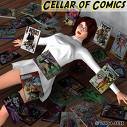Every project has its own unique set of “opportunities”—also known as challenges. Many of these challenges relate not to the quality of our work, but rather to the communication of our ideas. Often in the course of design, you must communicate complicated concepts to a non-technical (and often uninterested) project sponsor, client, or stakeholder. So how do you capture their interest, get their understanding and buy-in, and finally move on?
A Real-Life “Opportunity”
I work as a user experience designer on an interactive team at a mid-sized strategic communications firm, Capstrat, based in Raleigh, NC. One recent web project presented our team the opportunity to communicate using comics. We were redesigning a family of more than 120 individual franchisee websites into one common web strategy, look and feel, and information architecture (IA). The challenge (“opportunity!”) was that governing umbrella organization had never enforced any kind of control over the web and the brand had been fractured by an inconsistent online user experience.
Our team was faced with getting consensus from a committee of more than 40 individuals, all with equal interest and many with their own motives. We knew getting buy-in from this hugely diverse group on the design for the new common web strategy and CMS was essential.
- The overall look and feel of the new websites
- How external users would move through the website to complete common scenarios
- How the site design would maintain brand and structure consistency when propagated out to more than 120 individual sites while still offering flexibility to accommodate each website’s individual needs
- How a non-technical administrator for each of the individual websites would engage and interact with a CMS to set up and maintain their site
We knew that presenting wireframes or flow diagrams to such a large group had the potential to be disastrous, but we also recognized that presenting flat visual design screenshots would leave too many unanswered questions. That’s when we considered the idea of using comics.
Why Comics?
Comics are becoming recognized as an effective means of communicating difficult concepts to diverse audiences—even in the most staid corporate environments and with the most serious topics.
In fact, in August 2006, Sid Jacobson and Ernie Colon released “The 9/11 Report: A Graphic Adaptation,” an illustrated digest of the 9/11 Commission’s 586-page report. About their choice of the comic medium, they said, “In a culture that has become the most visually oriented in the history of humankind, comics retain the original concept of storytelling and remain a potent force of information.” It is the storytelling attribute of comics that allows them to strike an un-intimidating and familiar chord with many audiences, even when dealing with sobering topics such as the 9/11 terrorist attacks.
Comics are effective not only because they are essentially narrative, but also because they are unpretentious, easy to follow, and accessible. Whereas a functional specification document uses words and often “tech speak” to communicate functionality, comics use pictures and interactions to get ideas across. Comic artist and Yahoo! staffer Kevin Cheng put it best, calling comics “the universal language.”
In contrast to many of the common tools of our trade (for example, use cases and process flows), the sequential nature of comic frames can communicate the progression of time (see image 1). Scott McCloud, author of “Understanding Comics,” notes that “creating meaning differences” in sequential comic frames is what transforms a series of separate illustrations into the “art of comics.”


No comments:
Post a Comment